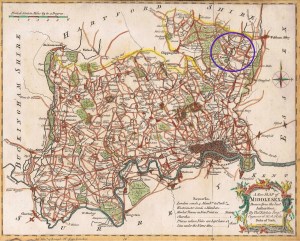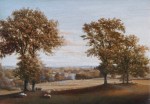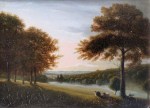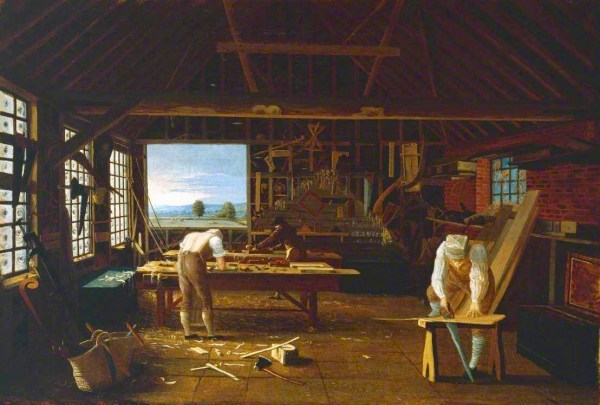
In “The Tate Gallery Illustrated Biennial Report 1983-1984” two of the recently acquired works were paintings of carpentry shops. The articles that discuss the history and importance of the acquired works are usually written by curators and museum department heads. In the case of the two carpentry shops the Tate Gallery (now Tate Britain) asked Jack Warans, a member of the Tate carpentry staff, to write the article for the Biennial Report. Warans’ article, “Inside Two Carpenter’s Shops” discusses “The Carpenter’s Shop at Forty Hill, Enfield” by John Hill and “Christ in the House of his Parents (The Carpenter’s Shop)” by John Everett Millais.
Although John Hill’s painting is greatly admired in the woodworking world and has been used in numerous publications it is also a source of frustration. The lack of a strong light source and the deep shadows keep much of the painting’s incredible detail just out of reach. The viewer can see “the corners but not the heart” of the shop. Jack Warans had the opportunity to make a close study of the painting, and I think his description of Hill’s shop (and a few enlargements) will help you see the details that make this a special work of art. And, he has something to say about the axe on the floor.
‘The Carpenter’s Shop at Forty Hill, Enfield’
“‘The Carpenter’s Shop at Forty Hill, Enfield’ by John Hill, an almost forgotten artist, was acquired for the Tate Gallery chiefly because its subject matter is unusual and the picture very convincingly painted. Hill was self-taught as an artist, but there is nothing naive about the fresh and direct style which he displays here. This picture was in fact probably exhibited at the Royal Academy in 1813 under the title ‘Interior of a Carpenter’s Shop’.
“John Hill was himself a carpenter and builder at Forty Hill. This scene probably represents his own workshop, and the figure of the master of the shop (seen at its farther end), whose moleskin hat and dark jacket distinguish him from his assistants in their white caps and shirtsleeves, may be a self-portrait. But although this picture depicts a particular carpenter’s shop early in the nineteenth century any modern spectator who has experienced the traditional techniques and customs of a carpenter’s training will recognise every detail of the scene. And the closer you look at this painting, the more detail you will see in it. None of these details are picturesque props; all of them are painted from first-hand knowledge of the carpenter’s trade.

“The three men at work in this interior are not posing for the artist. Each of them is absorbed in his work and in command of the task to which he is putting his skills. Every one of them is evidently a fully qualified carpenter, for each has his own tool-box close at hand. These tool-boxes were (and still are) usually begun in the last years of a carpenter’s apprenticeship, and might take several years to finish. On the outside these tool-boxes look plain and serviceable; they were usually painted green, as these are. When opened they revealed the finest workmanship of which the craftsman was capable; they usually consisted of twelve drawers, the whole elaborately inlaid and veneered. Tool-boxes served two chief purposes; they enabled a carpenter to keep his own personal tools safely and tidily, and they could be shown to a prospective employer as evidence of a carpenter’s skill. Within a workshop they also served an everyday practical purpose in giving the carpenter somewhere to sit and eat his midday meal.
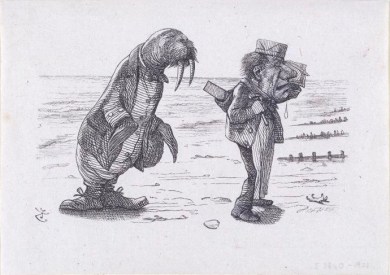
“The white caps worn by the master carpenter’s two assistants were traditional for several centuries, and were worn by tradesmen such as plasterers and house-painters. They were made of stout paper, folded into a box-like shape. A similar cap is worn by the Walrus’ friend the Carpenter in Tenniel’s illustrations to Alice: Through the Looking-Glass.
“For those who would like to know more about the picture but are not familiar with the carpenter’s trade, it may be a help to state just what we can see in it. We are looking into the interior of a small joinery shop, made chiefly of timber but with one brick wall. The floor is made of flagstones, which in winter would probably have been covered with wooden pallets.
 “The windows on either side of the shop are glazed with small panes of bottle-glass; broken panes have been stopped by the time-honored custom of stuffing bundles of wood-shavings into the cracks. At the farthest end of the shop is a large unglazed opening, big enough for large pieces of work to go through; this opening gives ventilation and maximum light (and, incidentally, a charming view of the countryside outside), and it is at this vantage point the master of the shop has chosen to station himself. This opening could be closed by outside shutters.
“The windows on either side of the shop are glazed with small panes of bottle-glass; broken panes have been stopped by the time-honored custom of stuffing bundles of wood-shavings into the cracks. At the farthest end of the shop is a large unglazed opening, big enough for large pieces of work to go through; this opening gives ventilation and maximum light (and, incidentally, a charming view of the countryside outside), and it is at this vantage point the master of the shop has chosen to station himself. This opening could be closed by outside shutters.
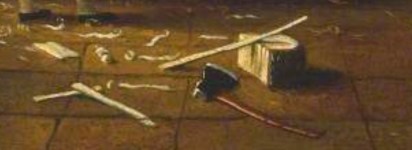
“In the centre of the foreground, an axe and a cross-cut log lie on the flagstones, probably to symbolise the first and most basic step in carpentry; this is the only slightly unrealistic note in the picture, for no carpenter would leave an axe on the floor like that.
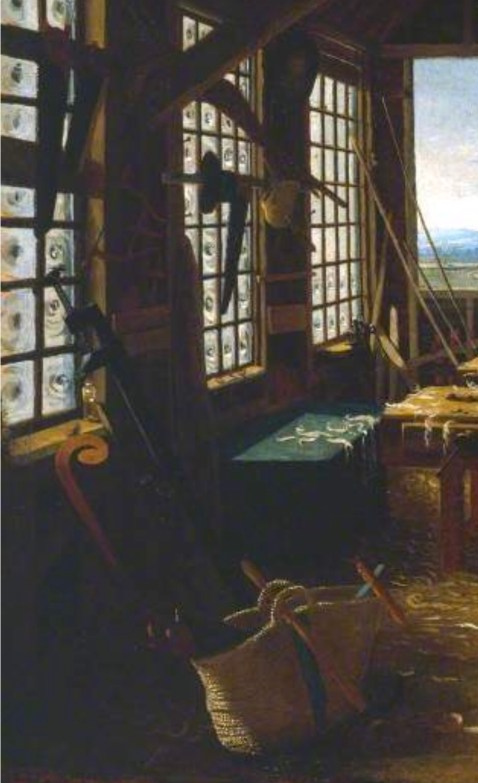 “On the left is a wicker basket used for carrying tools between the shop and work outside it; from it protrude a hand-saw, an adze, a gauge and what is either an unfinished staircase baluster or the template for it. Behind the basket is a sash-cramp, used (still) in the making of sash windows to glue or ‘cramp up’ their frames. Between the windows on the left hang hand-saws, a bow-saw and various templates; beneath the furthest window [on the sill] is a metal-working vice; which would extend the sort of work this workshop can undertake.
“On the left is a wicker basket used for carrying tools between the shop and work outside it; from it protrude a hand-saw, an adze, a gauge and what is either an unfinished staircase baluster or the template for it. Behind the basket is a sash-cramp, used (still) in the making of sash windows to glue or ‘cramp up’ their frames. Between the windows on the left hang hand-saws, a bow-saw and various templates; beneath the furthest window [on the sill] is a metal-working vice; which would extend the sort of work this workshop can undertake.
“The carpenter on the left, with his back to the spectator, is working at a carpenter’s bench, the basic design of which remained unchanged for centuries; on it lie several planes,

a wooden mallet, various dividers and pincers, a bradawl and a gimlet. This man is using a square to mark out a piece of timber for cutting; two pieces of wood which he has already stripped, planed and squared lie on the bench to the right. His fellow-assistant, on the right of the picture, is sawing a piece of marked-out timber on a wooden trestle or saw-horse.
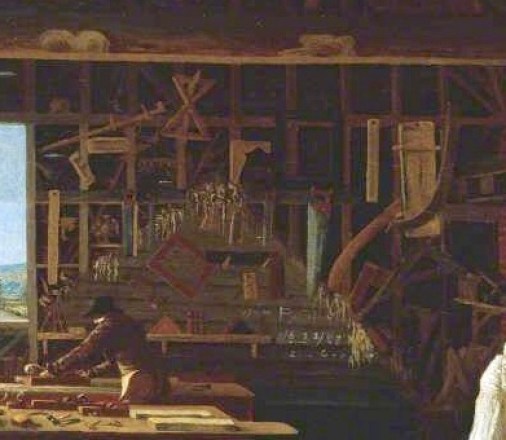
“At the far end of the shop the master is planing timber. The wood beams of the wall in front of him are hung with various tools, including several brass-backed tenon saws and a coffin-maker’s saw (used, not only in coffin-making, for sawing long joints) and with various templates, mostly for making heavy mouldings. One or two objects on this wall specifically refer to work carried out in this particular shop: for instance, a picture frame made of dark wood, or stained dark, perhaps made for one of Hill’s own paintings, and a carved eagle, perhaps a small version of a carving made for a church pulpit. Chalked numbers on the wall on the master’s right [to the right of the shelf] are presumably calculations for the work at hand.
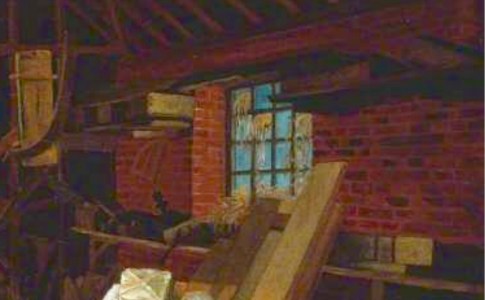
“The array of tools continues across the brick wall on the right, and includes several spare vices, boxes of pegs and nails and, at the extreme end [to the right of the boards], a mitre-block for cutting corners. The only indispensable items missing from this view are glue-pots; they must have been kept at the end of the workshop which is (as it were) occupied by the spectator and which probably gave approximately one-third more space to the workshop. Everything else which should be here is here; everything in this workshop has a practical function and is accurately depicted.”
Jack Warans also commented on Millais’ “Christ in the House of his Parents (The Carpenter’s Shop).” He noted “Millais included only such details as he wanted. His carpenter’s shop is not so much a place of work as a stage for a few carefully selected props. The most realistic detail is the carpenter’s bench, which is the same timeless design as the bench in Hill’s shop, as well as my own in the Tates’s carpenter’s workshop today…the tools on the wall at the back of this workshop include a bow-saw of the type peculiar to the cooper’s trade…and a hammer of the type used by upholsterers. There is no plane, yet that is of course indispensable in a carpenter’s shop.”
Jack Warans sums up the difference between the two paintings, on the one hand a carpenter’s shop painted by a carpenter, on the other hand a carpenter’s shop used as a backdrop for religious symbolism: “Millais’ picture is a semblance of reality rather than reality itself. In his carpenter’s shop, a set-square is not so much a set-square as a symbol of the Trinity. There are no symbolic overtones in Hill’s picture. Its realism is, literally, almost artless; but there is, and should be, room for Hill’s picture as well as Millais’ in the national gallery of British Art.”
A Little Bit About John Hill
John Hill’s approximate birth year is 1780, and he died in November 1841. His father, Thomas (died 1814), was a carpenter. According to the Tate, John was listed in an 1839 census as a carpenter and as a builder in an 1841 census. John was also a self-taught artist and six of his paintings survive. His painting of the carpenter’s shop is believed to be the same work exhibited at the Royal Academy in 1813. A label on the back of the painting (dated circa 1900) indicates the carpentry shop was Hill’s first completed painting and was done in 1800. If this early date is correct the master in the background of the shop could very well be his father.

Besides the painting of the carpenter’s shop he also painted Worcester Lodge where he probably lived. Landscapes around Forty Hill were another subject of Hill’s paintings.
His training as a carpenter seems to have given him a good eye for scale, perspective and detail.

Compare the ‘bottle-glass’ windows in the painting on the left with some real windows on the right. The glass is watery causing the light to be muted and the pontil in each pane distorts the view to the outside.
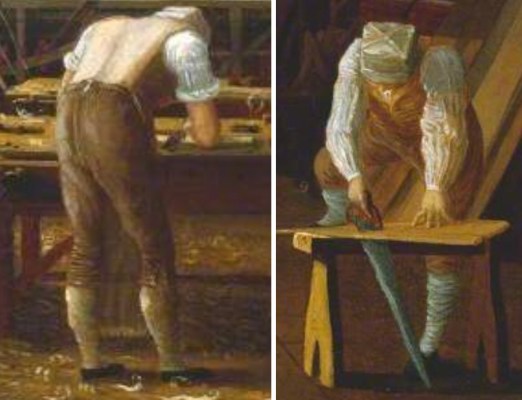
It is one thing to paint the human body standing straight and it is quite another to paint the body at work in a carpenter’s shop.
In the 1858 edition of “Historical, Topographical and Statistical Notices of Enfield in the County of Middlesex, Containing Also Brief Biographical Notices of Distinguished Persons Who Formerly Resided in the Parish” compiled by J. Tuff, Chemist, we find this note about John Hill:

Finally, here is what is thought to be a self-portrait of John Hill.
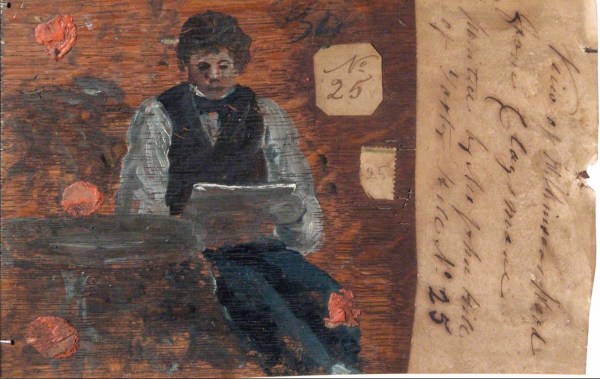
A couple notes on British English to Other English translations: a cramp is a clamp, a vice is a vise and mouldings are mouldings or sometimes moldings.
If seeing those square paper hats has got you fired up and you want to have one of your own (and one for your cat) you can read about the hats and get construction details here.
In the gallery below are a map showing the location of Enfield and Forty Hill, two landscapes by John Hill and the Millais painting.
— Suzanne Ellison
